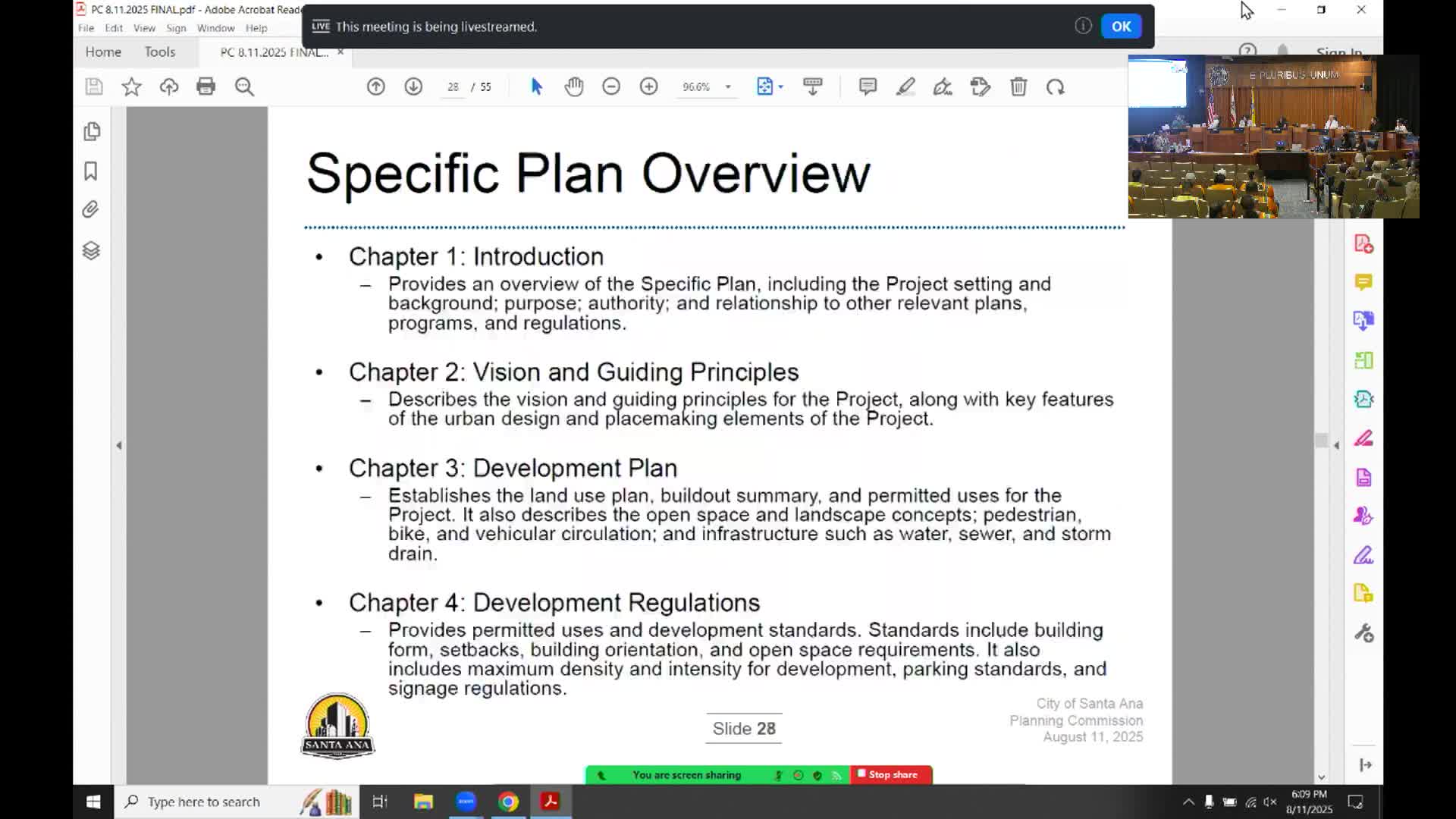City Council Reviews Santa Ana Village Specific Plan for 20-Year Development Project
August 12, 2025 | Santa Ana , Orange County, California
This article was created by AI summarizing key points discussed. AI makes mistakes, so for full details and context, please refer to the video of the full meeting. Please report any errors so we can fix them. Report an error »

The Santa Ana Planning Commission convened on August 11, 2025, to discuss a significant development proposal known as the Village Santa Ana Specific Plan. This plan outlines a comprehensive framework for a mixed-use project that aims to reshape the area with residential, commercial, and office spaces over a projected timeline of up to 20 years.
The specific plan is organized into six chapters, each detailing essential components of the project. Chapter 1 introduces the plan's purpose and its relationship to existing city frameworks, including the general plan and the city's master bicycle plan. Chapter 2 presents the vision and guiding principles, emphasizing urban design and community integration. Subsequent chapters cover the development plan, regulations, design guidelines, and administration, ensuring a structured approach to project implementation.
The project is set to unfold in five phases, beginning with the construction of 360 residential units and 73,000 square feet of commercial space. Subsequent phases will add hundreds more residential units and significant commercial and office space, with the final phase completing the project with an additional 269 residential units. Each phase will undergo staff-level review, with certain thresholds requiring further scrutiny by the Planning Commission.
The proposal aligns with the city’s general plan, which allows for a maximum density of 125 dwelling units per acre. The Village Santa Ana project proposes approximately 93 units per acre, maintaining compatibility with surrounding neighborhoods. Building heights will be capped at 25 stories, with specific limits near adjacent residential areas to minimize impact.
In addition to the specific plan, the applicant is seeking a zone change and a vesting tentative tract map to facilitate the subdivision of the project site into six lots. This will enhance financing opportunities and streamline the development process. A development agreement is also being proposed, which will govern land uses and establish terms for the project over a 20-year period, with potential extensions.
The Planning Commission's discussions highlighted the project's potential to meet community needs while adhering to regulatory standards. The next steps involve further evaluations and recommendations to the city council, which will ultimately decide on the approval of the specific plan and associated requests.
The specific plan is organized into six chapters, each detailing essential components of the project. Chapter 1 introduces the plan's purpose and its relationship to existing city frameworks, including the general plan and the city's master bicycle plan. Chapter 2 presents the vision and guiding principles, emphasizing urban design and community integration. Subsequent chapters cover the development plan, regulations, design guidelines, and administration, ensuring a structured approach to project implementation.
The project is set to unfold in five phases, beginning with the construction of 360 residential units and 73,000 square feet of commercial space. Subsequent phases will add hundreds more residential units and significant commercial and office space, with the final phase completing the project with an additional 269 residential units. Each phase will undergo staff-level review, with certain thresholds requiring further scrutiny by the Planning Commission.
The proposal aligns with the city’s general plan, which allows for a maximum density of 125 dwelling units per acre. The Village Santa Ana project proposes approximately 93 units per acre, maintaining compatibility with surrounding neighborhoods. Building heights will be capped at 25 stories, with specific limits near adjacent residential areas to minimize impact.
In addition to the specific plan, the applicant is seeking a zone change and a vesting tentative tract map to facilitate the subdivision of the project site into six lots. This will enhance financing opportunities and streamline the development process. A development agreement is also being proposed, which will govern land uses and establish terms for the project over a 20-year period, with potential extensions.
The Planning Commission's discussions highlighted the project's potential to meet community needs while adhering to regulatory standards. The next steps involve further evaluations and recommendations to the city council, which will ultimately decide on the approval of the specific plan and associated requests.
View full meeting
This article is based on a recent meeting—watch the full video and explore the complete transcript for deeper insights into the discussion.
View full meeting
